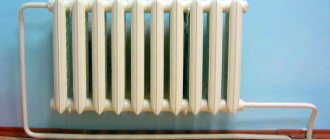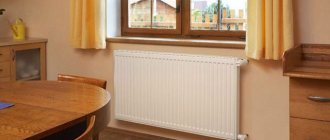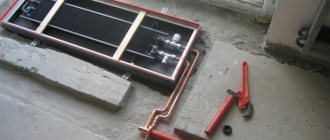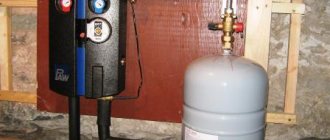How do bimetallic radiators work?
As already mentioned, bimetal batteries are based on two materials: steel and aluminum. The internal part of the structure (pipe), through which the coolant flows, is usually made of stainless steel (sometimes copper). This metal is very durable and does not respond to the negative influence of the aggressive environment of the heated coolant.
The outer side is made of aluminum and is a casing with fins. Aluminum has high thermal conductivity, warms up in the shortest possible time and the air in the room begins to warm up instantly.
Construction of bimetallic radiators
The inner and outer parts of each section are joined together by casting. This process is carried out under pressure or spot welding. Using steel nipples and heat-resistant gaskets that can withstand a maximum temperature of no more than 200°C, the sections are assembled into a battery.
The fact that the design of a bimetallic radiator contains parts made of steel is due to a number of positive characteristics that this metal has:
- steel can withstand pressure changes;
- steel is highly resistant to electrochemical influences, while internal surfaces made of aluminum quickly rust, and therefore their service life is short.
However, in turn, aluminum is characterized by high thermal inertness. On the one hand, this is an advantage, but on the other, it is a kind of disadvantage. Aluminum surfaces react very quickly to even minimal changes in temperature. Thanks to this property, you can very quickly adjust the temperature parameters of the heated room.
Due to the high heat transfer of aluminum, less coolant is consumed, while the amount of heat released is identical to that coming from cast iron radiators. That is why the dimensions of bimetallic heating radiators are more compact, and the shapes are very attractive in appearance.
Advantages and disadvantages
By purchasing an installation made of bimetal, your heating system will be provided with many positive aspects:
- First of all, it has a long service life. Thanks to the high quality of the design, which combines two good materials, such radiators can operate effectively for 30-50 years.
- Durability and reliability. These qualities are ensured thanks to the steel core, which is able to withstand high operating pressure and hydraulic shocks.
- Bimetallic heating radiators are suitable for any heating system, even with low-quality coolant.
- High heat transfer is another important positive quality. Due to the fact that the outer casing is made of aluminum, heat is distributed throughout the room very quickly. Standard models, in which the distance between the axes is 500 mm, have a heat transfer of up to 190 W, which is significantly more than in radiators made of only one metal.
- Thanks to the built-in thermostat, you can control and regulate the heating temperature.
- Externally, bimetal batteries are very attractive. Various color and design solutions allow everyone to choose a radiator to suit their taste.
As you can see, bimetallic radiators have a large number of advantages, which determine wide demand for such products. However, there are also some disadvantages that cannot be ignored when choosing:
- Different coefficients of expansion of steel and aluminum. In this regard, after long-term operation, noise and squeaks may occur in the heating circuit, and the strength of the structure will be lower.
- During the installation of radiators in a central heating system, heat-conducting pipes can quickly become clogged. This is due to the fact that they have a small diameter. Given this feature, it is better to be careful and install a coarse filter.
- High price of bimetallic radiators.
You can find out what material radiators are made from in this article.
Pressure and other characteristics of steel radiators
Wiring diagram for a steel radiator.
Related article: Covering a balcony with MDF panels (photos and videos)
In new multi-storey buildings with two-pipe heating systems, the pressure in which is up to 10 atmospheres, steel radiators are most often installed. They look very attractive and are characterized by high heat transfer.
By their design, such batteries represent a system with horizontal and vertical water channels and an additional U-shaped surface. The elements of such batteries are made of stamped steel sheets and connected by welding. The fins of the steel radiators are connected to each other using perpendicular panels, so dust does not collect in the corners of such radiators. The standard depth of such batteries is 63, 100 and 155 mm, the height varies from 300 to 900 mm, and the width from 400 to 3000 mm.
Steel radiators come in tubular and panel types. Panel devices are devices that are used mainly in private homes or in rooms where there is low operating pressure. They are convenient because they are produced in different sizes and thermal power, which makes it possible to choose the battery needed specifically for a specific room and ready-made sizes of mounting niches. Steel radiators are produced throughout Europe and are of good quality in assembly and painting.
Steel tubular radiators are widely used heating devices with an elegant appearance that fits well into any interior. As a rule, tubular batteries are used in individual heating systems. Such devices are characterized by low thermal inertia, which makes it possible to easily regulate the temperature in a heated room. Tubular models have an elegant design, a wide variety of standard sizes and a wide color palette.
Steel batteries weigh less than cast iron ones, the metal in them is thinner, as a result of which they heat up faster. In addition, such batteries are characterized by a high degree of heat transfer due to their design features and large heating area.
Such heating batteries are designed for temperatures up to 150 degrees and pressure up to 10 bar. They can be installed in houses with a small number of floors (up to 3 floors), apartments and office premises.
Types of bimetallic radiators
Radiators made of bimetal come in two types: monolithic and sectional.
Sectional ones are constructed from sections, each of which, inside horizontal pipe sections on both sides, has a multidirectional thread, through which connecting nipples with sealing gaskets are screwed in.
It is this design that is one of the most important shortcomings of bimetal batteries. The downside is that defects very often appear at the joints, for example, from low-quality coolant. As a result, the service life of radiators is reduced.
Also, in areas where sections are connected, leaks may occur under the influence of high temperatures. To avoid such unpleasant moments, another technology for the production of bimetallic heating radiators has been created. Its essence lies in the fact that initially a solid welded manifold is made of steel, then it is placed in a special mold and aluminum is poured on top of it under high pressure. Such radiators are called monolithic.
Both varieties have their advantages and disadvantages. We have already talked about the disadvantages of sectional ones, but their advantage is that if one section is damaged, then it is enough to just replace it. But if a breakdown or leak occurs in a monolithic structure, you will have to purchase a new radiator.
Let's conduct a comparative analysis of monolithic and sectional bimetallic radiators.
| Performance characteristics | Sectional bimetallic radiators | Monolithic bimetallic radiators |
| Service life, years | 25-30 | up to 50 |
| Working pressure, bar | 20-25 | up to 100 |
| Thermal power of one section, Watt | 100-200 | 100-200 |
The cost of a monolithic radiator is approximately 20% higher than a sectional one.
Pressure and other characteristics of aluminum batteries
If for some reason the boiler is turned off, be sure to drain the hot water from the radiator, otherwise the pipes may burst.
In multi-storey buildings with central heating and in individual heating systems of cottages and apartments, aluminum batteries are often used. They are designed for a pressure of 16-18 atmospheres. Aluminum radiators have a modern design, excellent thermal and strength parameters and are currently the most common.
Article on the topic: Inexpensive fence for a summer residence. What is cheaper to make a fence from?
They are made from die-cast aluminum. This manufacturing technology allows us to ensure high strength of finished products. Aluminum radiators are structures made of separate sections from which batteries of the required length are assembled. They come in sizes of 80 and 100 mm deep with a standard section width of 80 mm.
Aluminum has a thermal conductivity 3 times greater than that of steel or cast iron, so such batteries have a very high heat transfer rate. The high thermal power of radiators of this type is also achieved due to additional fins, which provide a large contact area between the air and the heated surface.
Aluminum radiators are designed for pressure from 6 to 20 atmospheres. Reinforced models of aluminum batteries are also produced, designed for the CIS countries - for apartment buildings with a central heating system with more severe operating conditions. Such batteries are made of durable high quality aluminum and have thicker walls.
Aluminum heating radiators are small-sized and lightweight, while they are characterized by high heat transfer. They have an attractive appearance. It is generally accepted that such batteries are optimal in conditions of autonomous heating (cottages, private houses, dachas, estates). However, the working pressure of aluminum radiators of 16 atmospheres allows them to be installed in apartments of multi-storey buildings.
Selection of bimetallic heating radiators
When choosing bimetallic batteries, you should pay attention to a number of criteria on which the operating efficiency will depend.
More information about manufacturers of bimetallic radiators can be found here
Design
As already noted, radiators can be monolithic or sectional. In order to choose the most optimal option for a specific heating system, you need to know what the operating pressure is in the system. If it is exposed to powerful water hammer, then it is better to give preference to monolithic models. In all other cases, it is recommended to purchase sectional ones, since they are much cheaper.
To purchase a more reliable device, you should know that there are two types. The first type is made of a steel frame, the other is equipped only with steel-reinforced channels through which the coolant moves.
Batteries belonging to the first type are characterized by greater strength and reliability. In such designs, the coolant does not come into contact with the aluminum alloy, as a result of which the risk of corrosion is minimal.
The main features characterizing the first type are weight and cost. They are produced by the following companies: Royal Thermo BiLiner, Global Style, Rifar (Monolit model) and the domestic company Santekhprom BM.
Another type is called semi-bimetallic radiators. The main characteristics of such devices: high heat transfer and lower price. The most popular devices are Gordi, Sira and Rifar brands, excluding the Monolit model.
Center distance
Most manufactured models of bimetallic radiators are equally functional. However, the distance between the axles varies among models. Standard distances between axles: 35 and 50 cm.
You can find radiators in which the gap is 20 cm; this length is considered the minimum. Batteries with this distance are produced by the following companies: Sira, BiLUX and RIFAR. The maximum distance is 80 cm; such models are available from the manufacturer Sira.
Material of manufacture
It is important that the radiator withstands the effects of an aggressive environment well if the coolant is of insufficient quality and contains a large amount of alkali and acidity. This is mainly typical for batteries in apartment buildings.
Also:
- It is important that the internal channels are made of the same metal, preferably stainless steel.
- The wall thickness of the inner pipe should be 3-3.5 mm.
- The quality and elasticity of the gaskets plays a very important role. They are the ones that influence the reliability of the connections, so rubber or silicone is usually used as the manufacturing material for them. To check the quality of the O-ring, just bend it with your fingers. If the gasket is rigid and inelastic, then this indicates its low quality.
- If the radiator is sectional, then you should pay attention to the nipples. It is important that they are made of high quality steel. The low quality of these parts is evidenced by the softness of the metal. If it is of poor quality, then the hooks for the key will definitely break off and in this case the nipple will need to be sawed with a grinding machine and its parts removed from the holes of the sections.
- The width of the front part of the radiator fin should be more than 70 cm. If this figure is lower, this will affect the heat transfer of the radiator in a negative direction. The most optimal ratio of section size to cross-section is 80*80 mm. With such indicators, heat transfer will definitely be high.
- The thickness of the protruding ribs also indicates quality. This figure should be no lower than 1 mm.
Guarantee
The warranty period also speaks about the quality of the product. If the manufacturer gives a service life of only 1-2 years, this means that the likelihood that the radiators will work with high efficiency is small, because The operational period of a quality product is 20-30 years.
Radiator selection
The heating device will last for 20 years only if the quality of the materials that make up the radiator is high. Not least important is the build quality and technological process of manufacturing the radiator.
What you should first pay attention to when purchasing:
- The wall thickness of the steel pipe , which is the base, must be at least 3 mm thick. If the thickness is less, then the strength of the product is significantly reduced, which will not be able to withstand high coolant pressure. If the internal pipes are made of very thin metal, then even with a slight corrosion process, water in the steel pipe can form access to aluminum, which has even greater chemical reactivity. In this case, the heating device will not last for several years due to the formation of holes on the working surface. Considering the fact that there is hot liquid under pressure inside the heating device, it is necessary to carefully consider the choice taking into account the wall thickness of the internal steel pipes.
- The aluminum jacket must also be made from a material that has sufficient strength. You can check this parameter during inspection in the store. If the force of the fingers of one hand bends the ribs, then it is better to refuse to purchase such a heating device.
- You can distinguish a low-quality product by the size of the section and the thickness of the ribs. The width and thickness of the section should not be less than 80 mm, and the radiator fins should be at least 1 mm thick.
- It is necessary to carefully inspect the section of the bimetallic heating device , because the device can only be half made of bimetal. Sometimes there are models that do not have horizontal or vertical steel pipes. In this case, the radiator will have significantly less weight. It is better to refuse such a half-bimetallic heating device. After all, those areas where there is no steel pipe actually do not have the advantages of bimetallic radiators.
- The use of low-quality gaskets and nipples in a heating device significantly reduces the service life of the radiator. Often, an indirect sign of the use of low-quality materials is the provision of a short warranty period by the manufacturer of this model. A high-quality bimetallic radiator can last more than 20 years, and in the case when the warranty on the device is only 1 year, it is better to refuse the purchase.
Specifications
The technical characteristics of batteries include dimensions. The height of radiators ranges from 20 to 80 cm. To select a radiator of the right size, you need to take into account the distance between the base of the window and the floor and subtract 20 cm from this number. The width is directly dependent on the location where the device will be installed.
Another important indicator is the working pressure, which varies between 15-35 atm. For centralized heating systems, it is better to choose the maximum values; for autonomous ones, the minimum values are also possible.
One of the most important and significant criteria affecting the efficiency of radiators is power. This indicator is determined based on the power of one section (it is indicated in the data sheet).
Calculation of sections of bimetallic heating radiators
In order to calculate the required number of sections based on the area of the room, you need to use the formula. To make the calculation, you need to know the following parameters: the power of one section and the area of the heated room.
In order to effectively heat 1 m² of area, you need 100 W of thermal energy. To calculate the area of a room, you need to multiply the width by the length.
Formula:
N= S*100/PN - number of radiator sections, S - room area, m², P - specific thermal power of one section.
Use the calculator to calculate the required number of sections of a bimetallic radiator.
Features of choosing a specific option and carrying out calculation work
Even though bimetallic products are very effective and economical, if the calculations are incorrect, the system will not function as required, so first of all you need to determine all the criteria, which we will talk about below.
What factors need to be considered
First, you should decide where the heating elements will be located. It makes the most sense to place them under the windows so that a thermal curtain is created opposite the window openings; sometimes you can place the batteries in other places, everything again depends on the characteristics of the room and its size.
Of the most important parameters, we note the following:
- The size of the bimetallic radiator section in height , you need to take measurements to know how much space is available. Next, 10 cm is subtracted from the obtained value for the distance from the floor, 10 cm for the distance from the window sill, also do not forget that the back wall should not be located close to the wall, there should be a gap of 50 mm. The final figure will tell you which option should be used in your case.
Important! Do not forget that sections are classified according to the center distance, which can range from 20 to 180 cm, but the actual size will be 7-8 centimeters larger, depending on the product manufacturer.
Elements of great height are rare, but if you want to find them it will not be difficult, although the price will be much higher
- The width of the bimetallic radiator section is always standard and is 80 mm , based on this you determine how much space the structure will occupy horizontally. Most often there is enough space, but sometimes the gap is too narrow, in which case the best option is to install two small batteries next to each other or separately.
Calculate the width so that the supply pipes fit
- The dimensions of the section of bimetallic heating radiators include not only the width and height, but also the depth (or thickness) , it is standard and is 85 mm, that is, taking into account the distance from the wall, the structure will protrude by 135 mm (in extreme cases, you can position it a little closer, but a gap of less than 30 mm is undesirable).
This diagram shows the two most popular options with center distances of 350 and 500 mm; these are the parameters that should be followed
- Also at this stage you should consider the option of fastening the structure . Although the products are not heavy, for example, the weight of a bimetallic radiator for 10 sections with a height of 580 mm is a little more than 15 kg, a certain load on the wall will still be present, so if the surface is covered with plasterboard, then we recommend making a stiffener at the level of the brackets.
Calculation work
Now let’s figure out how to calculate the number of sections of bimetallic heating radiators for a particular room.
This type of work can be done with your own hands, and simple instructions will help you with this:
- First you need to calculate the volume of the room, everything is very simple: the length, width and height are measured, after which the obtained indicators are multiplied among themselves. The result will be the volume of the room in cubic meters.
Calculating the volume is not difficult
- According to SNiP standards, one cubic meter of air in a room should account for 41 W of thermal energy; if the building is well insulated and plastic double-glazed windows are installed, then 34 W per cubic meter is sufficient. Let's consider an example: a 3x4 room with a height of 2.5 meters has a volume of 30 m3, let's say our house is not very well insulated, so we multiply 30 by 41 and get 1230 W.
- Based on this result, you can calculate the number of sections of a bimetallic radiator, but it is better to introduce correction factors for greater accuracy. For example, the diagram below shows how heat is lost in private houses; as for urban buildings, then you need to add 10% for each window, from 5 to 10% if the radiator is located in a niche and 25% if the room is corner.
Heat loss will be significantly reduced if you insulate your house well
Now let’s figure out how to calculate the number of sections of a bimetallic radiator, in the example above we learned that 1230 W of thermal power is required, let’s say there are two external walls and one window in a room, that is, you need to add another 35% to the result, you get 1660 W. Let's take as an example a section with a power of 190 W, but, as you know, the system does not operate constantly at maximum temperature, so it is better to add another 10-15% of the reserve, in the end it turns out that we need a bimetallic radiator for 10 sections.
You can use an even simpler option so as not to bother with calculations - find an online calculator, enter all the data into it and get the finished result. Everything is quite simple and fast, the most important thing is to enter all the necessary values correctly.
The question often comes up: what is the maximum number of sections in a bimetallic radiator that can be installed? There is no indication of this in the building codes, there is only a recommendation that the structure should be assembled in a factory; of the manufactured options, the largest are those with 14-18 sections, this is the number that can be considered a reasonable maximum, if you need more, it’s easier to split two block system.
Such a radiator is difficult to install; it’s easier to use two small options
Installation of heating radiators made of bimetal
Bimetal batteries must be installed in accordance with the instructions specified in the device passport.
In order to connect a radiator with your own hands, you need to take into account a number of factors:
- It is better to choose the middle of the window as a location for the battery;
- installation is carried out exclusively in a horizontal position;
- You need to maintain a distance of 3-5 cm from the wall to the battery. If you place the radiator too close to the wall, the result will be uneven distribution of heat;
- the distance to the window sill should be 8-12 cm, if it is less, it will negatively affect the heat transfer of the batteries;
- distance from the floor to the battery is 10 cm.
Installation of all system elements is carried out in a plastic radiator package. This packaging must not be removed until the entire installation process has been completed. The procedure for installing bimetallic heating radiators:
- Initially, you need to mark the proposed area on the wall where the brackets will be attached;
- then the brackets are fixed;
- batteries are installed on them;
- Next, the radiator must be connected to the pipes;
- then a thermostatic valve or faucet is installed;
- An air valve is installed at the top of the battery.
Everything about brackets for mounting radiators is written at the link
Manufacturers
Currently, on the heating equipment market you can find a large number of different models of bimetallic radiators produced by both Russian and foreign manufacturers. Let's look at the main characteristics of the most popular models.
| Model | Distance between axles, mm | Section size: width*height*depth (mm) | Maximum working pressure, Bar | Thermal power of the section, W |
| Rifar (Russia) | ||||
| Rifar Forza 350 | 350 | 415*90*80 | 20 | 136 |
| Rifar Forza 500 | 500 | 570*100*80 | 20 | 202 |
| Rifar MONOLIT 350 | 350 | 415*100*80 | 100 | 136 |
| Rifar MONOLIT 500 | 500 | 577*100*80 | 100 | 194 |
| Global Radiatori (Italy) | ||||
| Style 350 | 350 | 425*80*80 | 35 | 125 |
| Style 500 | 500 | 575*80*80 | 35 | 168 |
| Style Plus 350 | 350 | 425*80*95 | 35 | 140 |
| Style Plus 500 | 500 | 575*80*95 | 35 | 185 |
| Royal Thermo (Italy) | ||||
| BiLiner Inox 500 | 500 | 574*80*87 | 20 | 171 |
| BiLiner 500 | 500 | 574*80*87 | 20 | 171 |
| Tenrad (Germany) | ||||
| Tenrad 350 | 350 | 400*80*77 | 24 | 120 |
| Tenrad 500 | 500 | 550*80*77 | 24 | 161 |
| Gordi (China) | ||||
| Gordi 350 | 350 | 412*80*80 | 30 | 460 |
| Gordi 500 | 500 | 572*80*80 | 30 | 181 |
| Sira Industrie (Italy) | ||||
| Gladiator 200 | 200 | 275*80*80 | 30 | 90 |
| Gladiator 350 | 350 | 275*80*80 | 30 | 140 |
| Gladiator 500 | 500 | 423*80*80 | 30 | 185 |
| LLC Litiz (Ukraine) | ||||
| Altermo LRB | 500 | 575*82*80 | 18 | 169 |
| Altermo RIO 500 | 500 | 570*82*80 | 18 | 166 |
| Grandini (Italy) | ||||
| Grandini 350 | 350 | 430*80*82 | 16 | 130 |
| Grandini 500 | 500 | 580*80*80 | 16 | 167 |
Thus, high-quality bimetallic heating radiators are able to operate effectively for a long period of time.











